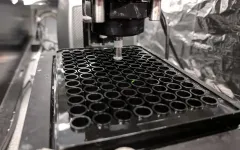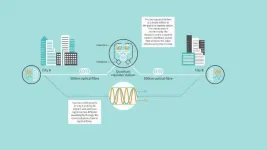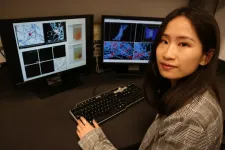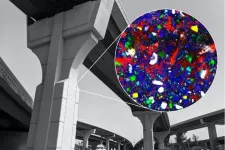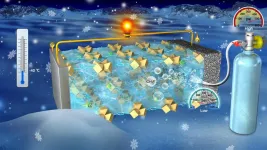(Press-News.org) BINGHAMTON, N.Y. -- New research from Binghamton University, State University of New York shows the human trauma and family separation that resulted from the Trump Administration's zero tolerance policy on undocumented immigration.
The news reports surrounding the Trump Administration's "zero tolerance" policy on undocumented immigration were stark: children separated from their parents, uncertain whether they would ever see them again.
All told, the official zero tolerance policy lasted only a few months, from April to June 2018. But family separations occurred before and after those dates: at least 5,512 children were separated from their families since July 2017, and 1,142 families were separated even after the policy formally ended.
Along with four Binghamton students, Assistant Professor of Human Development Óscar F. Gil-García put a human face on these tragic statistics in "'It felt like my son had died': Zero tolerance and the trauma of family separation," recently published in the journal Latino Studies, the article documents the impact of immigration policy on a Central American family that became separated in 2017 from their son David, a minor and a United States citizen.
As the Biden administration begins to reunify families, the case of David and his family provides an opportunity to comprehend the long-term harm inflicted by family separations, said Gil-García, who is also affiliated with Latin and Caribbean Area Studies (LACAS).
"Immigration policies in the U.S. and Mexico are really damaging to migrant populations; they paint migrant populations as not human, but as criminals and as undeserving," said co-author Sarah Vener '22, an English and political science dual major. "We see that this creates human rights abuses that have real impacts on people throughout their lives -- and those impacts last."
Vener has spent three years as a research assistant under Gil-García, exploring the effects of U.S. and Mexican immigration policy on indigenous Maya refugees. Co-authors also include Francesca Bové '21, who recently graduated with a master's in public administration; psychology major Luz Velazquez '21; and sociology, human development and LACAS triple-major Alexandra Miranda '22.
The interview with David came out of a larger project that Gil-García has been working on since around 2012, concerning members of a Maya community living in the Mexican state of Chiapas. Gil-García worked with these stateless individuals on obtaining legal status in Mexico; David's parents, Evelyn and Carlos, were among them.
The two had fled Guatemala in 1985 to escape that nation's civil war. Lacking legal status and job opportunities in Mexico, they crossed the border to work at an Alabama sweatshop. David was born in the United States in 2003, making him a U.S. citizen.
He first became separated from his father at only 4 years old, when he and his mother returned to Mexico, concerned about rising deportations; Carlos joined them two years later. At the age of 14, David expressed interest in returning to the United States for his education. His father joined him, believing that his son's U.S. citizenship meant that he could accompany him. That proved not to be the case.
The two were immediately separated by immigration officials. After two months' detention, Carlos was deported to Mexico in February 2018. David ended up in the Arizona foster care system, and neither knew the whereabouts of the other for months.
Frantic, Carlos and Evelyn enlisted Gil-García's help in tracking down their son, who ended up in three different foster-care facilities. Unable to speak English, he was at times unable to communicate in his group home, and struggled with eating and sleeping. Gil-García worked with David's family to expedite his release. Just as the coronavirus began to spread, David was finally able to leave the foster care system and live with a family member in California.
While David's story may seem uniquely tragic, he's not alone, the researchers stress; more than 5.9 million children who are citizens of the United States have at least one undocumented parent and live with the constant fear of family separation.
Such separations have long-lasting health consequences for both the children and their families, including forms of post-traumatic stress disorder (PTSD), anxiety, depression and other conditions that can shorten life expectancy. Family separations also meet the definition of an enforced disappearance, which is considered a crime in international law -- and even the United Nations' definition of torture, the researchers note.
For all the pain they inflict, zero tolerance policies are largely ineffective in deterring migration; in fact, they have the opposite effect, Gil-García noted.
"These kinds of separations are actually creating new forms of migration and compelling these individuals to re-migrate," he said.
Gil-García and his research team have other projects in the works concerning experiences like that of David and his family. One will conceptualize a heuristic model for practitioners who want to help unaccompanied minors cope with the trauma of family separation.
INFORMATION:
Anyone who collects mushrooms knows that it is better to keep the poisonous and the non-poisonous ones apart. Not to mention what would happen if someone ate the poisonous ones. In such "classification problems", which require us to distinguish certain objects from one another and to assign the objects we are looking for to certain classes by means of characteristics, computers can already provide useful support to humans.
Intelligent machine learning methods can recognise patterns or objects and automatically pick them out of data sets. For example, they could pick out those pictures from a photo database that show non-toxic ...
A 3D printer that rapidly produces large batches of custom biological tissues could help make drug development faster and less costly. Nanoengineers at the University of California San Diego developed the high-throughput bioprinting technology, which 3D prints with record speed--it can produce a 96-well array of living human tissue samples within 30 minutes. Having the ability to rapidly produce such samples could accelerate high-throughput preclinical drug screening and disease modeling, the researchers said.
The process for a pharmaceutical company to develop a new drug can take up to 15 years and cost up to $2.6 billion. It generally begins with screening tens of thousands of drug candidates in ...
NEW YORK, NY--A new global study of 30-day outcomes in children and adolescents with COVID-19 found that while death was uncommon, the illness produced more symptoms and complications than seasonal influenza.
The study, "30-day outcomes of Children and Adolescents with COVID-19: An International Experience," published online in the journal Pediatrics, also found significant variation in treatment of children and adolescents hospitalized with COVID-19.
Early in the pandemic, opinions around the impact of COVID-19 on children and adolescents ranged from it being no more than the common flu to fear of its potential impact on lesser-developed immune systems. This OHDSI global network study compared the real-world observational data of more ...
The emerald ash borer, an invasive beetle native to Southeast Asia, threatens the entire ash tree population in North America and has already changed forested landscapes and caused tens of billions of dollars in lost revenue to the ash sawtimber industry since it arrived in the United States in the 1990s. Despite the devastating impact the beetle has had on forests in the eastern and midwestern parts of the U.S., climate change will have a much larger and widespread impact on these landscapes through the end of the century, according to researchers.
"We really wanted to focus on isolating the impact of the emerald ash borer ...
An experimental, lab-made antibody can completely prevent nonhuman primates from being infected with the monkey form of HIV, new research published in Nature Communications shows.
The results will inform a future human clinical trial evaluating leronlimab as a potential pre-exposure prophylaxis, or PrEP, therapy to prevent human infection from the virus that causes AIDS.
"Our study findings indicate leronlimab could be a new weapon against the HIV epidemic," said the study's lead researcher and co-corresponding author of this paper, Jonah Sacha, Ph.D., an Oregon Health & Science University professor at OHSU's Oregon National Primate Center and Vaccine & Gene Therapy Institute.
"The results of this pre-clinical ...
Cambridge, UK, 7th June 2021: The Cambridge Research Laboratory of Toshiba Europe today announced the first demonstration of quantum communications over optical fibres exceeding 600 km in length. The breakthrough will enable long distance quantum-secured information transfer between metropolitan areas and is a major advance towards building the future Quantum Internet.
The term Quantum Internet describes a global network of quantum computers connected by long distance quantum communication links. It is expected to allow the ultrafast solution of complex optimization problems ...
An international group of researchers has developed a new technique that could be used to make more efficient low-cost light-emitting materials which are flexible and can be printed using ink-jet techniques.
The researchers, led by the University of Cambridge and the Technical University of Munich, found that by swapping one out of every one thousand atoms of one material for another, they were able to triple the luminescence of a new material class of light emitters known as halide perovskites.
This 'atom swapping', or doping, causes the charge ...
Heart attacks and strokes -- the leading causes of death in human beings -- are fundamentally blood clots of the heart and brain. Better understanding how the blood-clotting process works and how to accelerate or slow down clotting, depending on the medical need, could save lives.
New research by the Georgia Institute of Technology and Emory University published in the journal Biomaterials sheds new light on the mechanics and physics of blood clotting through modeling the dynamics at play during a still poorly understood phase of blood clotting called clot contraction.
"Blood clotting is actually a physics-based phenomenon that must occur to stem bleeding after ...
The concrete world that surrounds us owes its shape and durability to chemical reactions that start when ordinary Portland cement is mixed with water. Now, MIT scientists have demonstrated a way to watch these reactions under real-world conditions, an advance that may help researchers find ways to make concrete more sustainable.
The study is a "Brothers Lumière moment for concrete science," says co-author Franz-Josef Ulm, professor of civil and environmental engineering and faculty director of the MIT Concrete Sustainability Hub, referring to the two brothers who ushered in the era of projected films. Likewise, Ulm says, the MIT team has provided a glimpse of early-stage cement hydration that is like cinema in Technicolor ...
A new technology could dramatically improve the safety of lithium-ion batteries that operate with gas electrolytes at ultra-low temperatures. Nanoengineers at the University of California San Diego developed a separator--the part of the battery that serves as a barrier between the anode and cathode--that keeps the gas-based electrolytes in these batteries from vaporizing. This new separator could, in turn, help prevent the buildup of pressure inside the battery that leads to swelling and explosions.
"By trapping gas molecules, this separator can function as a stabilizer for volatile electrolytes," said Zheng Chen, a ...
